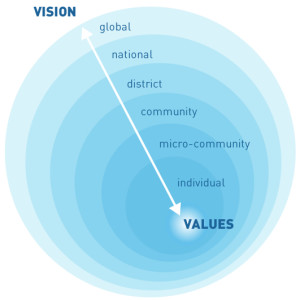We don’t see sustainable peace being led from the bottom-up, or from the top-down–but rather, from the inside-out.
Making visible the concentric circles of roles in the peacebuilding system, and the international aid system more generally, allows us to see the multiple points of action and impact, and the complete set of relationships, necessary for sustainable peace. Each level is important, and interconnected.
In our approach, we examine relationships between each level of “insider” and “outsider.” In the Nested Circles image, it is clear that at some point everyone is an ‘outsider,’ and at some point everyone is an ‘insider.’ For example, while the leader of a national NGO is an ‘insider’ to an international donor, they are ‘outsiders’ to regional and local communities.
We believe that when each level connects in healthy ways to the levels around it, the whole system is healthy. Examining and working at those relationships, then, becomes everyone’s job.
At the center of the circle is the individual. People as people. In the case of Fambul Tok’s program of community reconciliation, it is often pairs of people, a victim and a perpetrator from the civil war in Sierra Leone, who are able to come together to apologize, forgive, and to begin to heal their wounds from the war. These are the ones the work is ultimately all for – those most impacted by the conflict and violence, or other humanitarian crisis.
The ‘micro-community’ is an even smaller unit than the local community. Micro-communities are the local sub-groups—sometimes formally organized, like a church, club, or community-based organization, sometimes not—through which individuals engage in a good deal of the activity of their lives. In peacebuilding processes, this is the level that most directly reaches and engages people in their lived lives, and where networks of trust are strongest.
The community is the next most intimate setting, and there are often more formal structures of organizing already present at this level – chiefs, youth representatives, women’s representatives, religious representatives, etc. This represents a core part of identity, and the real space of belonging, the literal ground that hosts, shapes and supports people’s day-to-day lives.
There is a regional organizing space that collects communities together, and in turn empowers and enables work across communities. This can exist in several layers – in Fambul Tok, there is a structure at the sectional level (a section is a collective of anywhere from 4 to 25 or more villages), and at the chiefdom level, on the way to the main organizing structure at the district level. This midpoint level of organizing¾between the national and the local communities¾can be uniquely powerful for actually connecting to communities and to the individuals that live there.
If a district structure is the end point of national efforts to reach communities, the work can end up feeling and being disconnected and distant from people’s lives. If district structures are platforms to support more localized organizing, however, they can be a powerful place to ground local leadership and structures for practice and learning. This is critical in supporting a healthy balance of the decentralization of power necessary for community agency, and the organizational infrastructure to support strategic impact and sustainability.
The national level is easily recognizable, and it is the space national NGOs inhabit, as well as national governments. At their best, national structures can play critical roles in organizing and supporting community-based work, and in turn strengthening the voice of community needs in the national arena. They can martial national and international support, and they can speak with strong voices on the global stage. Without intentional process and structure for connecting to communities, however, national NGOs can perpetuate outside-in, disempowering approaches, leaving communities worse off than before an intervention. And if internationally-led peacebuilding initiatives don’t go further in than the national level in their concept and organizational process, they can be feeding into this negative dynamic.
The international or ‘global’ level is also obvious, as the point from which other nations, individually or collectively through intergovernmental organizations, engage to support peace and development. It also represents the space where people from other nations engage – chiefly through international NGOs or other communities of practice, including academic and research bases. Most funding comes from this level, and that funding can include externally defined and prescribed programming, or it can proactively create space for local leadership and agency. In an inside-out model, action and support from this level aim to proactively create and hold the space for local leadership and ownership, recognizing the value of the local wisdom and resources, and supporting it to grow and lead.
An inside-out model also identifies and makes space for the international level to learn from the levels further in on the model. The two-way direction of action and learning is critical, and most obviously missing at the international level.
International media occupies this space, since the stories that get told or not told play an important role in peace processes. See our Storytelling page for more on how we define and practice inside-out storytelling.
And what about the relationships?
That’s where the vision and values come in. When the vision includes seeing the strength and resources and wisdom of each level, the values define the way of working that allows you act that out in practice. Together, these build the bridges of connection and communication between levels that support healthy systems, whole people and communities, and sustainable peace.
Blog banner image (c) Sara Terry for Catalyst for Peace


